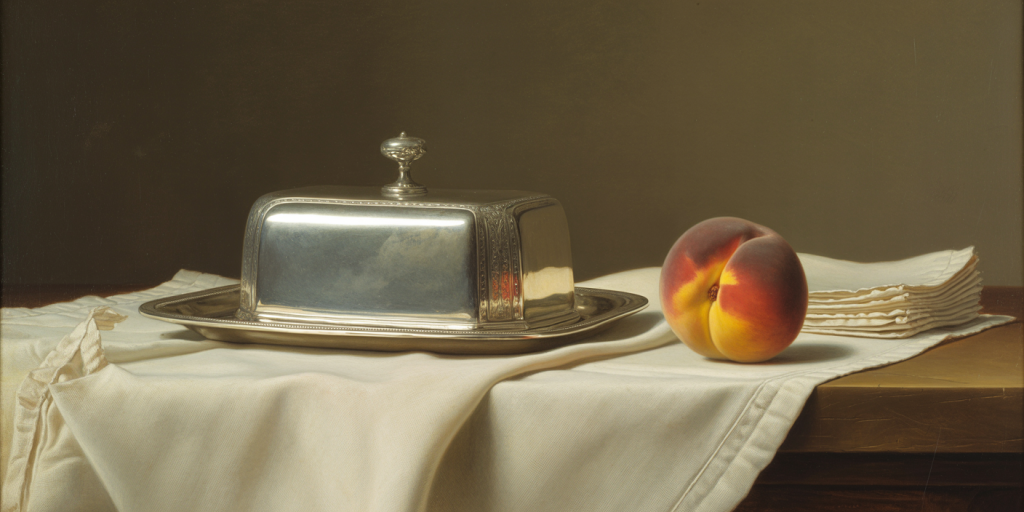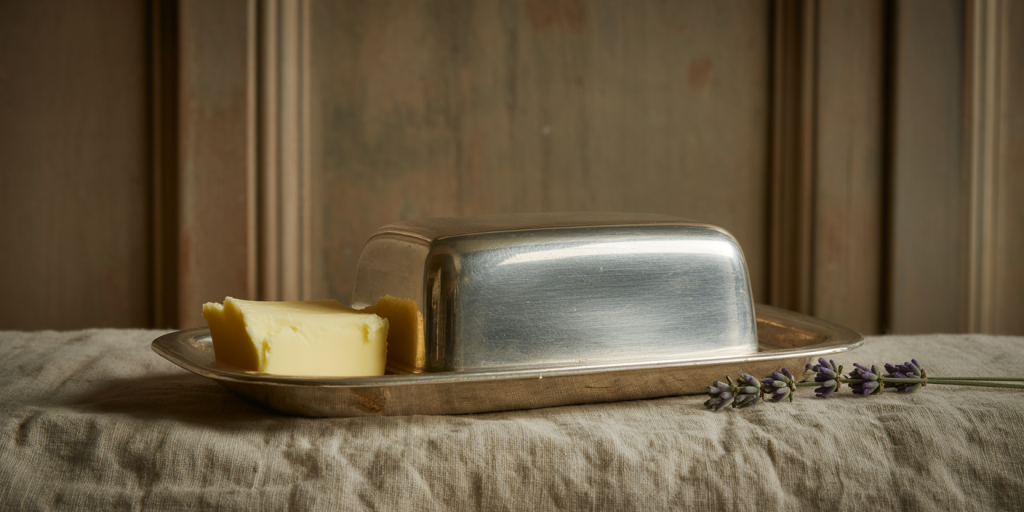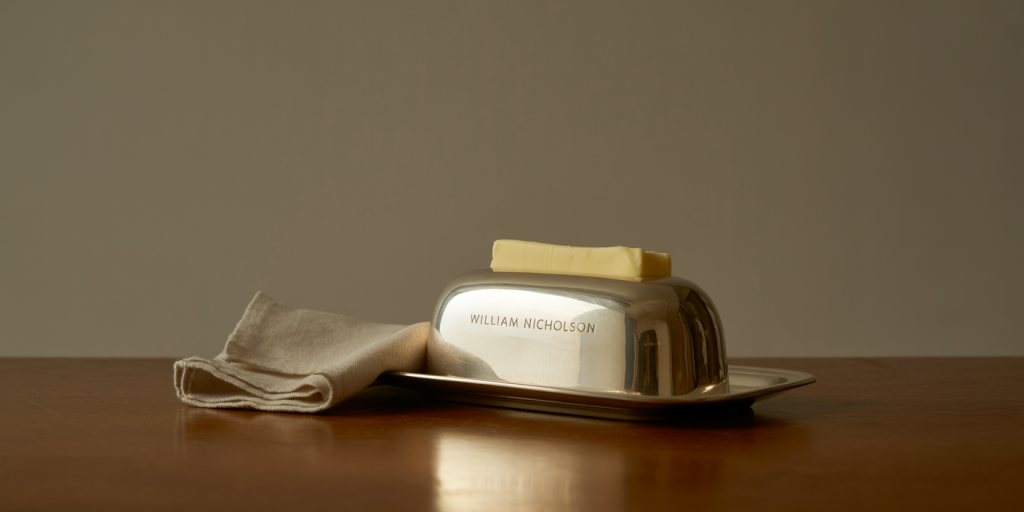William Nicholson and the Silent Shine of the Butter Dish
William Nicholson
When Light Bows Over Silver
There are paintings that speak in grand declarations, and others that barely breathe. In the quietude of William Nicholson’s still lifes, a butter dish becomes an altar. Its round lid reflects more than its surroundings—it reflects the mood of a room, the hush of a morning, the glint of a gaze not yet fully awake. It is not simply a container—it is a keeper of silence, of intimacy, of domestic sanctity.
Nicholson’s butter dish does not ask for attention; it absorbs it. Like a paused breath in a prayer, it sits, glimmering with subtle restraint. Its luster is neither showy nor cold—it is the warm gleam of things loved quietly. This is not opulence—it is reverence. This is not a dish—it is a poem carved in silver and painted in restraint.
Table of Contents
- The Butter Dish as Sanctuary
- Light That Rests Rather Than Strikes
- The Humility of Reflection
- Texture as Whisper
- Silver as Memory, Not Metal
- Shadows Like Folded Napkins
- The Object That Listens
- Composition in Soft Geometry
- Stillness That Gathers Meaning
- The Color of Contained Warmth
- The Butter Within as Metaphor
- Edges That Do Not Cut
- Emotional Realism in Restraint
- The Table as Horizon
- The Gaze of Tenderness
- The Historical Hum of the Dish
- Brushstrokes of Silence
- Presence Without Announcement
- An Everyday Object as Icon
- The Timelessness of Modest Things
The Butter Dish as Sanctuary
Nicholson’s butter dish is no mere utensil. It becomes a sanctuary for light, form, and contemplation. Nestled on a simple cloth, it gleams without noise—like a well-kept secret shared only with the attentive.
Its curves enclose space the way sacred architecture encloses prayer. This is not about butter—it is about keeping something unspoken safe. It invites nearness, yet holds mystery.

Light That Rests Rather Than Strikes
The light in Nicholson’s painting does not intrude. It rests. It bends. It drapes itself over the dome of the butter dish like velvet over a shoulder. This is not illumination—it is affection.
Each glint is carefully chosen—not to dazzle, but to speak. It tells us not of the dish itself, but of the time of day, the angle of the room, the intimacy of light that loves what it touches.
The Humility of Reflection
What the butter dish reflects is never loud. A corner of a table, a shadow, a smear of morning. Reflections here are not spectacle—they are murmurs. They remind us that we exist not alone, but in quiet contact with our surroundings.
Nicholson paints this humility with great care. The reflection does not claim space—it shares it. The dish becomes both self and mirror, both presence and witness.
Texture as Whisper
You do not touch the butter dish. You feel the memory of touch on its surface. The texture, softly burnished and rendered with delicate brushwork, is more suggestion than replication.
This whispering texture invites emotion rather than attention. The dish does not boast its material—it offers its softness like a hand cupped around flame. A vessel of quiet sensuality.
Silver as Memory, Not Metal
Silver, in this painting, is not cold or ornamental. It is warm, tender, reminiscent. It glows like old letters, like breath on a mirror. It carries history—not grandeur, but repetition. The silver here is the silver of familiarity.
Nicholson turns metal into emotion. Into routine made sacred. This is not ceremonial silver—it is kitchen silver, domestic, beloved. Silver as continuity, not wealth.
Shadows Like Folded Napkins
The shadows surrounding the butter dish are not voids—they are folds. They behave like napkins gently placed, like fabric slightly wrinkled by time. They contour the space without imposing.
These shadows cradle the dish. They allow its light to bloom. In them, we find the quiet dignity of preparation, the poetics of pause. A visual softness where the eye may rest.
The Object That Listens
Some objects speak. Others listen. The butter dish, in Nicholson’s care, is a listening object. It absorbs the mood of its environment. It reflects without judgment, curves without resistance.
It is an emblem of domestic empathy. It does not intrude—it accepts. In it, we sense the sensitivity of a painter who understood not just how things looked, but how they waited.
Composition in Soft Geometry
The arrangement is spare, precise, but never rigid. The butter dish sits slightly off-center—not for tension, but for invitation. The geometry is not mathematical—it is emotional.
The roundness of the dome, the softness of its base, the gentle slope of the table—they compose a visual haiku. Each shape answers the next. Balance is achieved not through symmetry, but through grace.
Stillness That Gathers Meaning
In this still life, stillness is not absence—it is accumulation. Each second of looking adds a layer. The butter dish gathers meaning like dew. It holds our gaze not through complexity, but through calm.
It becomes a center of gravity for the scene. Around it, time slows. Around it, the world quiets. The dish is not passive—it is anchor.
The Color of Contained Warmth
The palette is restrained—grays, creams, the faintest gold—but within that restraint lies a surprising warmth. The dish glows not with heat, but with memory of heat.
Nicholson paints color like one remembers perfume: indirectly, emotionally. The tones do not dazzle—they stay. They settle into the retina and whisper there.
The Butter Within as Metaphor
Though we rarely see the butter itself, we feel it. Its presence is implied by the lid, by the promise of function. And so, it becomes metaphor—of softness, of preservation, of interior life.
The butter is the self beneath the surface. It is what is kept safe, kept cool, kept ready. It is the reward of patience. The fruit of domestic ritual.
Edges That Do Not Cut
The form of the butter dish is round, polished, kind. There are no sharp corners, no aggressive lines. Even the table seems softened by its presence.
These gentle edges soothe. They reflect a visual language of peace. In a world often rendered with tension and assertion, Nicholson offers shape as comfort.
Emotional Realism in Restraint
Nicholson’s painting is realistic—but not photographically so. His realism is emotional. He does not record—he remembers. He refines the visual world into its essential, quiet truths.
The butter dish becomes real not because it is accurate, but because it feels known. His realism rests in suggestion, in silence, in restraint.

The Table as Horizon
The table here is not mere support—it is horizon. It stretches flat and firm beneath the dish, anchoring it like land beneath sky. Its wood grain or cloth becomes topography.
This turns the domestic into the epic. The butter dish is no longer just placed—it stands. It becomes a monument of the everyday. A peak of attention in the landscape of the home.
The Gaze of Tenderness
The way Nicholson paints the butter dish tells us about his gaze. It is not analytical—it is affectionate. His eye moves slowly, respectfully. There is no distance in his observation—only care.
This tenderness translates onto the canvas. The object becomes charged with affection, not sentimentality. He does not idolize the dish—but he honors it.
The Historical Hum of the Dish
Painted in a time of transition—between Victorian weight and Modernist flight—this butter dish hums with history. It carries the echoes of manners, rituals, breakfasts taken slowly.
It becomes a symbol of continuity. In its silence, it holds the ghost of laughter, the warmth of routine. A domestic relic made eternal by attention.
Brushstrokes of Silence
Nicholson’s brushstrokes are nearly invisible, yet their effect is loud in silence. Each touch is calibrated to vanish, to serve the whole. This is a humility of technique—craft that surrenders to clarity.
The result is not dryness—it is depth. A silence that draws the viewer in. The brush becomes a whisper, leading us closer to the object’s truth.
Presence Without Announcement
The butter dish does not call attention to itself. It waits. It trusts that the viewer will come. This presence without announcement is radical in its modesty.
In a world of noise, such painting feels like exhale. It is not less—it is more. More attentive, more honest, more enduring. The butter dish becomes a lesson in how to be.
An Everyday Object as Icon
By painting the butter dish with reverence, Nicholson turns it into an icon—not religious, but emotional. He shows us that the divine is not far—it is here, in the light on the table.
The ordinary becomes luminous through attention. The dish, painted this way, becomes an emblem of presence, of pause, of perception.
The Timelessness of Modest Things
Though rooted in its time, Nicholson’s butter dish feels timeless. Because modesty is timeless. Because care is timeless. Because the human need to notice, to preserve, to reflect—is eternal.
In this small, gleaming dome, the world slows. The brush meets breath. The viewer remembers what it is to see, not just with the eyes, but with the spirit.
FAQ – Understanding William Nicholson and His Butter Dish
Who was William Nicholson?
William Nicholson (1872–1949) was a British painter, printmaker, and illustrator known for his still lifes, portraits, and landscapes. His work blended simplicity with technical refinement.
What defines his still lifes?
Nicholson’s still lifes are marked by quiet compositions, modest subject matter, soft lighting, and emotional restraint. His brushwork is subtle, and his sense of space profound.
Why is the butter dish significant?
It exemplifies his ability to transform the everyday into art. The butter dish reflects his fascination with light, silence, and the poetics of domestic objects.
What techniques did Nicholson use?
He employed restrained palettes, smooth brushwork, and careful lighting to evoke intimacy and timelessness. His technique emphasizes clarity and calm rather than complexity.
Where can one see his works today?
His paintings are housed in collections such as the Tate (London), the Ashmolean Museum (Oxford), and other British institutions and private collections.
Final Reflections – The Light That Stayed
In Nicholson’s butter dish, we find not spectacle, but presence. Not the extraordinary, but the sacred ordinary. He reminds us that art does not require grandeur—it requires attention.
His butter dish glows not because of what it is, but because of how it is seen. And in seeing it, we learn again to look. To notice. To pause.
The brilliance of the butter dish is not in its shine, but in its silence. It is a mirror for our stillest selves. A dome that holds light and time, wrapped gently in silver and care.

